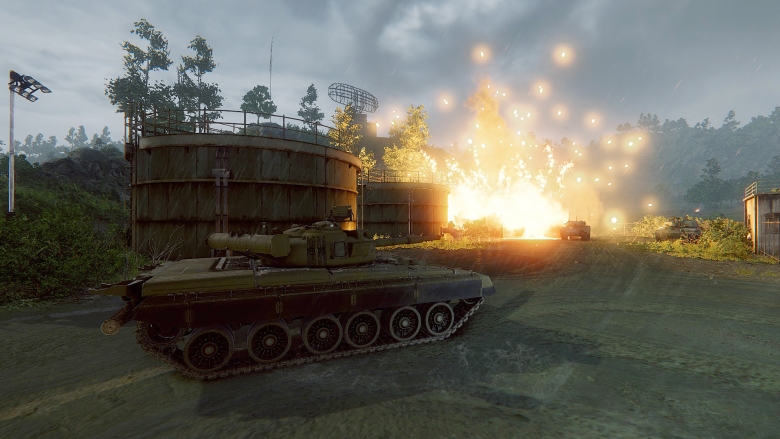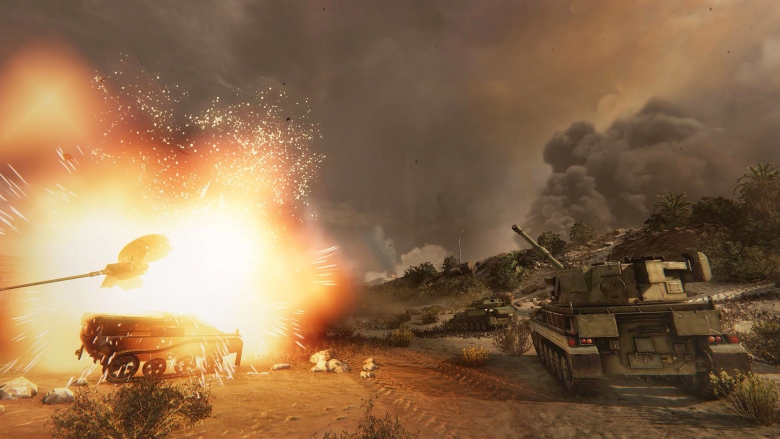
High Explosive rounds are unique in several ways. First, High Explosive rounds explode in an area of effect, potentially dealing damage to multiple components on a vehicle. High Explosive rounds from tank cannons and artillery can also potentially damage targets even if they do not hit them directly if a target is within their explosion radius. Note that autocannons firing high explosive rounds do not have this feature - autocannons need to hit a target directly to deal any damage.

If a High Explosive shell penetrates a target, it deals full damage and explodes inside the vehicle, potentially damaging internal components and crew. We have a rule that prevents all crew from being wiped out in a single explosion, however, to prevent one-shotting vehicles from being possible. If all crew would normally be wiped out in a single hit, the Commander will survive the explosion. Note that this only happens if the crew is all undamaged; it's possible for all crew to be wiped out if they've been previously hurt from another attack.
Splash (area damage)
Indirect hits from tank cannons and artillery deal a lower amount of damage, which we call "splash" damage.
Splash damage for tank cannons is 25% of the nominal damage of a shell. This is the minimum possible damage for tank cannon HE shells, so it is not reduced further by armor.
Splash damage for artillery shells is between 25% and 75% of nominal damage, depending on how far away from the vehicle the shell lands. Note that in the case of artillery, this damage can also be reduced further by the target's effective armor, down to a minimum of 25% of the nominal damage of the shell. This means artillery shells are better at splashing lightly armored targets than tank cannons are, but their splash damage will likely be just as low against heavier targets, such as MBTs.

In addition, components such as the treads, sights, etc. can be splashed. If this happens, the splash damage to these secondary components is split up based on how many secondary components were hit. Note that hull damage is not part of this "split" and is not reduced if the player hits additional components.
Interaction with Armor
Each High Explosive shell has a "Full Damage (Armor Threshold)" and a "Min Damage (Armor Threshold)" displayed in the tooltip. If a High Explosive shell hits an enemy vehicle, the damage is reduced if the target's effective armor thickness vs. HE exceeds the "Full Damage (Armor Threshold)" of the shell. This "Full Damage (Armor Threshold)" is usually a low number, meaning that High Explosive shells only deal full damage to very weakly armored locations.

If the target's effective armor thickness vs. HE is equal to or higher than the "Min Damage (Armor Threshold)", the shell deals its minimum possible amount of damage. For tank cannons and artillery, this is 25% of the nominal damage of the shell. For autocannons, this is currently 10% of the nominal damage of the shell, however we will be reducing it to 0 damage in the future, making it possible for autocannon HE shells to deal 0 damage if a target's armor is sufficiently thick.
If the target's armor thickness is in between the "Full Damage (Armor Threshold)" and the "Min Damage (Armor Threshold)", the shell's damage will be partially reduced. This last scenario can be explained with the following equation:
Damage Reduction % = ((Effective Armor Thickness vs. HE - Full Damage (Armor Threshold)) / (Min Damage (Armor Threshold) - Full Damage (Armor Threshold)).
For example, if the Full Damage (Armor Threshold) is 10, the Min Damage (Armor Threshold) is 100, and the effective armor thickness vs. HE of the target is 70, the equation is ((70 - 10)/ (100 - 10)), or (60/90). This results in 0.667, meaning the shell's nominal damage is reduced by 66.7%.
Some High Explosive shells have special mechanics. For example, HESH rounds (also known as HEP rounds) are capable of generating spall (which damages internal components and crew) even if they do not penetrate the enemy vehicle, as long as its damage is reduced by less than 50%.
Conclusion
Generally speaking, the High Explosive shells are very effective against targets with thin armor, but can also be used by low-power guns to deal at least some damage to targets with very thick armor where regular armor-piercing shells would simply bounce off.
We hope this article has made the HE shell mechanism a little more comprehensive. See you on the battlefield!








